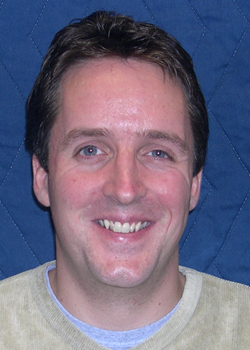
|
Stuart Loch Associate Professor Theoretical Atomic Physics Office: Allison Lab # 113 Address: Phone: (334) 844-5154 |
|
Education |
|
| Ph.D., University of Strathclyde, UK | 2001 |
| B.S., University of Strathclyde, UK | 1997 |
|
Professional Employment |
|
| Associate Professor, Department of Physics, Auburn University | 2011- present |
| Assistant Professor, Department of Physics, Auburn University | 2006-2011 |
| Research Scholar, Department of Physics, Auburn University | 2002-2006 |
| Research Scholar, University of Strathclyde | 2001 |
|
Honors and Awards |
|
| Selected by student votes to give the 2013 Final Lecture at Auburn University. | |
| Eugene J. Clothiaux Faculty Teaching Award, COSAM, Auburn University | 2013 |
| Professor of the Year, Honorary Member, Auburn Chapter of Alpha Epsilon Delta | 2013 |
| Malcolm Kerr Prize for Excellence in Ph.D dissertation | 2001 |
|
Professional Activities |
| Referee: |
| Physical Review A |
| Atomic Data and Nuclear Data Tables |
| Journal of Physics B |
| Reviewer: |
| DOE (Fusion Energy Science) |
| NASA (ARPA Lab Astrophysics Program) |
| Member: |
| American Physical Society |
| Institute of Physics (IOP) London |
|
Research and Teaching Interests |
My research approach is inherently collaborative. The aim is to generate high quality atomic data for use in fusion and astrophysics. A central part of this is to be involved in the use of the data in analysis of real plasma experiments. Thus, myself and the other theoretical atomic physicists at Auburn have collaborations with a range of experimental groups. This has been further strengthened through the joint faculty position with ORNL. We collaborate with atomic physics experimentalists, to help benchmark the fundamental cross sections that we generate. The atomic data is then processed into a form most useful for modelers. We collaborate with fusion plasma researchers who use the data for diagnostics and modeling of their experiments, and with astrophysics researchers, who use our data for spectral diagnostics. It is my belief that there is much benefit to be obtained from being able to both generate fundamental atomic data and process it into the form of most use in plasma modeling. Along with collaborators at Auburn, Rollins College (FL), the University of Strathclyde (UK) and the JET tokamak (UK), I am part of a program to update the atomic data for use in fusion and astrophysics. This is largely done through the Atomic Data and Analysis Structure (ADAS) suite of codes (www.adas.ac.uk). My research is split into three main areas: (1)Atomic data generation. Using state-of-the-art atomic physics codes, myself and collaborators are working on updating the atomic data used in fusion and astrophysics. The fundamental data is processed into temperature and density dependent coefficients known as generalized collisional radiative coefficients (GCR). To give a few examples of current projects: 1.We recently completed data for H, He, Li, Be and B. We are currently completing the GCR data for C. 2.We have also been working on improving the atomic data for complex species such as tungsten, which is to be used in the divertor strike points of the ITER experiment, currently under construction in France. I am working on improving the atomic data used for W and Mo. 3.I have started a new project aimed at calculating meaningful error bars on atomic data and processing these errors through to spectral predictions, in collaboration with Mike Witthoeft at the Goddard Space Flight Center (GSFC). As far as I know no-one has developed a systematic approach to putting meaningful error bars on theoretical atomic data. (2)Support of fusion plasma experiments. Much of the atomic data that we make is for use in fusion plasma diagnostics/simulations, through spectral diagnostics or impurity transport modeling. (3)Astrophysical applications. Recent X-ray spectral observations of local bright supernovae remnants tentatively identified emission from Mn and Cr. However, the atomic data necessary to interpret these observations was not present. So I am currently generating atomic data for Cr, Mn, Co and Ni, in direct support of these experiments. We have finished generating electron-impact excitation data for the Hlike ions and are almost finished the He-like data. The data will be used to analyze X-ray spectra from the XMM-Newton and Suzaku telescopes, in collaboration with researchers at the GSFC. |
|
Selected Publications |
|
Last updated: 05/07/2015
